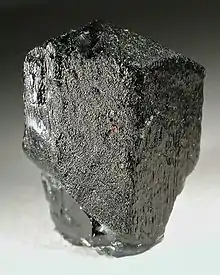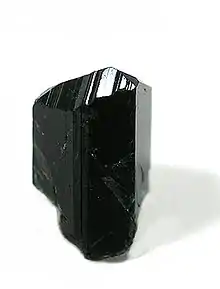Serendibite
Serendibite is an extremely rare silicate mineral that was first discovered in 1902 in Sri Lanka by Dunil Palitha Gunasekera and named after Serendib, the old Arabic name for Sri Lanka.
| Serendibite | |
|---|---|
 A relatively sharp, vitreous black crystal of serendibite from Le Oo, in Mogok Township, measures: 16 x 13 x 8 mm | |
| General | |
| Category | Inosilicates |
| Formula (repeating unit) | (Ca,Na)2(Mg,Fe2+)3(Al,Fe3+)3[O2|(Si,Al,B)6O18] |
| Strunz classification | 9.DH.40 |
| Dana classification | 69.2.1a.6 |
| Crystal system | Triclinic |
| Crystal class | Pinacoidal (1) (same H-M symbol) |
| Space group | P1 |
| Identification | |
| Color | pale yellow, blue-green, greyish blue, black |
| Twinning | Polysynthetic on {0-11} is common |
| Cleavage | None Observed |
| Mohs scale hardness | 6.5 - 7 |
| Luster | Vitreous |
| Streak | White |
| Diaphaneity | Transparent, Translucent,Opaque |
| Specific gravity | 3.42 - 3.52 (measured) 3.47 (calculated) |
| Optical properties | Biaxial (+) |
| Refractive index | 1.701 - 1.706 |
| Pleochroism | Visible,strong, color: green, blue, yellow, bluegreen, light yellow |
| 2V angle | Measured: 80° |
| Dispersion | strong |
| References | [1][2] |
The mineral is found in skarns associated with boron metasomatism of carbonate rocks where intruded by granite. Minerals occurring with serendibite include diopside, spinel, phlogopite, scapolite, calcite, tremolite, apatite, grandidierite, sinhalite, hyalophane, uvite, pargasite, clinozoisite, forsterite, warwickite and graphite.[2]

Crystal from Mogok, Myanmar, size: 1 cm x 0.7 cm x 0.7 cm
See also
This article is issued from Wikipedia. The text is licensed under Creative Commons - Attribution - Sharealike. Additional terms may apply for the media files.